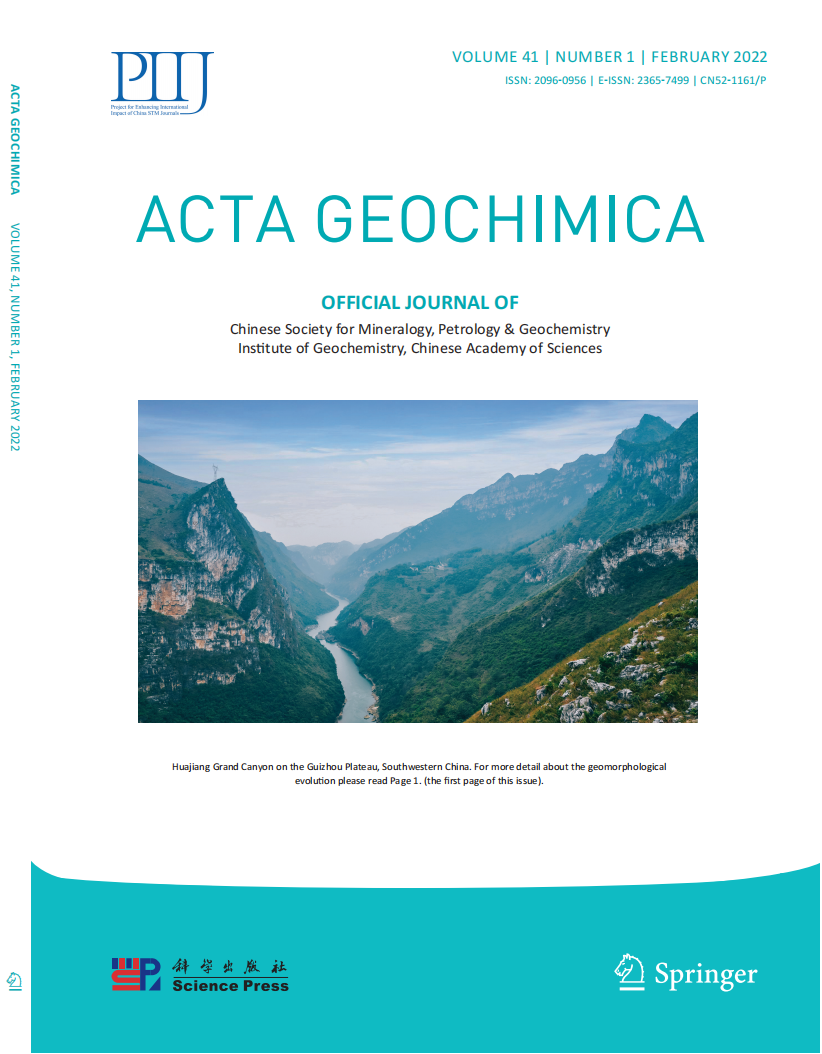- 钛学术文献服务平台 \
- 学术期刊 \
- 基础科学期刊 \
- 化学期刊 \
- 地球化学学报(英文)期刊 \
Geochronology and geochemistry of the five magmatic rocks in the Ningzhen region, China
Geochronology and geochemistry of the five magmatic rocks in the Ningzhen region, China
原文服务方:
地球化学学报(英文)
摘要:
The Ningzhen region of China is located in the easternmost part of the middle-lower Yangtze River Cu–Fe polymetallic metallogenic belt. From west to east, it comprises five main intermediate–acidic intrusive complexes: the Qilinmen, Anjishan, Xiashu–Gaozi, Shima, and Jianbi complexes. Geochemical investigations show that these five intrusive complexes exhibit high contents of SiO2, at 64.74–73.40 wt%, Al2O3, at 14.15–17.37 wt%, and K2O + Na2O, at 6.49–8.68 wt%. The majority of the samples belong to the high-K calc-alkaline series, with a few samples plotting in the calc-alkaline and tholeiitic series. Trace element analysis shows that the samples are enriched in large ion lithophile elements (LILE) and are depleted in high field strength elements (HFSE). The chondrite-normalized rare earth element (REE) patterns are characterized by right-inclined curves, showing light rare earth element (LREE) enrichment. In addition, the (La/Yb)N ratios are high at 15.02–37.28, with an average of 29.13, and slightly negative or none Eu anomalies are present. In the (La/Yb)N–dEu diagram, the samples plot within the crust-mantle type field. Laser ablation–inductively coupled plasma–mass spectrometry (LA–ICP–MS) zircon U–Pb dating yielded ages of 122.0 ± 1.0 Ma, 106.1 ± 0.8 Ma, 108.7 ± 1.4 Ma, 103.5 ± 1.9 Ma, and 96.8 ± 1.7 Ma for the Qilinmen, Anjishan, Xiashu–Gaozi, Shima, and Jianbi complexes, respectively. On the basis of this research and knowledge of several known metal deposits related to these complexes, we suggest that the Mesozoic large-scale diagenesis and metallogenesis in the Ningzhen region may have ceased at 100 Ma or about 95 Ma.

推荐文章
Identification of bacterial fossils in marine source rocks in South China
South China
Excellent marine source rocks
Bacterial fossil
Sedimentary environment
Metallogenic controls on the granite-related W–Sn deposits in the Hunan–Jiangxi region, China: evide
W–Sn deposits
South China
Zircon trace element chemistry
Ti-in-zircon thermometry
Oxygen fugacity
Geochemistry and petrogenetic evolution of metasedimentary rocks in Bunu Area, part of Kabba-Lokoja-
Geochemical studies
Metasedimentary rocks
Geodynamic activities
Protolith
Passive continental margins
Age and geochemistry of Early Ordovician A-type granites in the Northeastern Songnen Block, NE China
Early Ordovician
A-type granite
Songnen and Xing'an blocks
Geodynamic setting
内容分析
关键词云
关键词热度
相关文献总数
(/次)
(/年)
文献信息
| 篇名 | Geochronology and geochemistry of the five magmatic rocks in the Ningzhen region, China | ||
| 来源期刊 | 地球化学学报(英文) | 学科 | |
| 关键词 | Intermediate–acidic intrusive complexes LA–ICP–MS zircon U–Pb dating Geochemistry Geodynamic setting Ningzhen region | ||
| 年,卷(期) | 2019,(2) | 所属期刊栏目 | |
| 研究方向 | 页码范围 | 241-261 | |
| 页数 | 20页 | 分类号 | |
| 字数 | 语种 | 英文 | |
| DOI | 10.1007/s11631-019-00316-2 | ||
五维指标
版权信息
全文
- 全文.pdf
引文网络
引文网络
二级参考文献 (0)
共引文献 (0)
参考文献 (0)
节点文献
引证文献 (0)
同被引文献 (0)
二级引证文献 (0)
2022(0)
- 参考文献(0)
- 二级参考文献(0)
- 引证文献(0)
- 二级引证文献(0)
研究主题发展历程
节点文献
Intermediate–acidic intrusive complexes
LA–ICP–MS zircon U–Pb dating
Geochemistry
Geodynamic setting
Ningzhen region
研究起点
研究来源
研究分支
研究去脉
引文网络交叉学科
相关学者/机构
期刊影响力
地球化学学报(英文)
主办单位:
中国科学院地球化学研究所
出版周期:
双月刊
ISSN:
2096-0956
CN:
52-1161/P
开本:
大16开
出版地:
贵州省贵阳市观水路46号地球化学研究所
邮发代号:
创刊时间:
1982-01-03
语种:
英文
出版文献量(篇)
294
总下载数(次)
0
期刊文献
相关文献
推荐文献

 免费查重
免费查重










